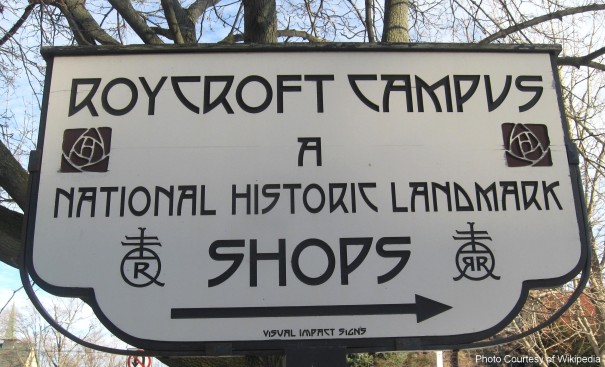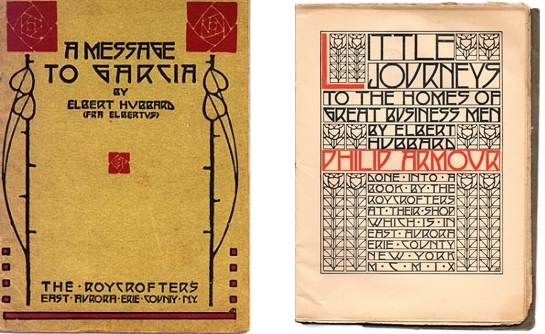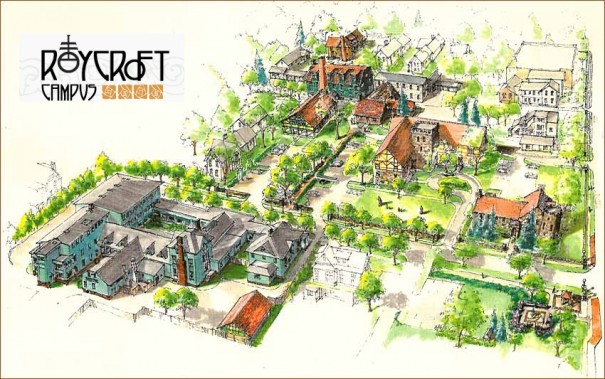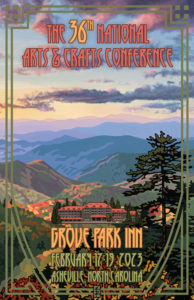This week I traveled to Western New York State for business and while there I was able to spend some time in the Arts & Crafts artisan community of “Roycroft” in East Aurora, just outside of Buffalo. The Roycroft Campus was founded in the late-1890’s by Elbert Hubbard, who along with Gustav Stickley, is considered one of the fathers of the Arts & Crafts Movement in America.

I stayed at the fantastic Roycroft Inn (pictured below) which is situated at the center of the campus and has been a hub of activity since it first opened its doors to guests in 1905. After undergoing a meticulous multi-million dollar restoration in 1995, the Inn is looking just as it did when it thrived in the early years of the last century.
Each room is unique and beautifully furnished with original antique Roycroft furniture as well as gorgeous present-day Stickley reproductions. There is always a docent on-site that is more than happy to share the history of the Inn and Campus with guests. Many thanks to docent Robb Mair who gave me a personal hour-long tour of the Inn!

Elbert Hubbard, who had made a small fortune as a partner in the Larkin Soap Company, started a printing company in East Aurora in the mid-1890’s called The Roycroft Press. His publications were printed with elaborate book-binding and typography using traditional handcrafted methods, following in the footsteps of William Morris, who had started the Arts & Crafts movement in England in the latter part of the 19th Century. Soon the Roycroft Campus became a hot-bed for like-minded furniture makers, metalsmiths, leathersmiths and other craftspeople who flocked to East Aurora to join in the movement.
In 2011, Hubbard was the subject of a very well-done PBS documentary entitled, Elbert Hubbard: An American Original. Below are a couple clips that introduce Hubbard and the colony of artisans he pioneered.
Following the success of his writings, Little Journeys and A Message To García, Hubbard had attained notoriety across the country – not only as a writer, but as a philosopher as well. In the years that followed, he would embark on national book and lecture tours in support of his work, all the while spreading the word of the free-thinking utopian Roycroft community.

Throughout the first decade of the 1900’s, The Roycroft Campus continued to thrive and Hubbard oversaw every aspect of it. The Campus grew rapidly and in 1909 construction began on its own powerhouse that featured coal-fired steam generators that provided heat and electricity to the campus and its workshops. Hundreds of craftsman style bungalows soon dotted the town and were home to many of the talented craftspeople that now called East Aurora home.

By the early 1910’s, the Roycroft “brand” had expanded beyond publishing and furniture making to include everything from lighting and stained glass to pottery and jewelry. Prominent Arts & Crafts artists like Dard Hunter and Karl Kipp were among the bigger names to emerge out of the Roycroft community and their work is still highly sought after today.
As tensions in Western Europe mounted leading up to World War I, The Roycroft would soon suffer a setback that would change the campus forever. On May 1, 1915 Hubbard and his wife Alice boarded a cruise ship in New York bound for Liverpool, England. That ship was the RMS Lusitania. Six days later, a German U-Boat fired a torpedo that hit and sank the luxury liner 11 miles off the Old Head of Kinsale Lighthouse on the southern coast of Ireland.

Ernest Cowper, who was with the Hubbards on the deck of the ship when the torpedo hit, later reported that upon realizing what had just occurred, Elbert stoically remarked, “Well, Jack, they have got us. They are a damn sight worse than I ever thought they were.” Alice smiled and replied, “There does not seem to be anything to do.” Cowper then witnessed the Hubbards return to their room on the boat deck and close the door behind them. Sadly, Elbert and Alice Hubbard were among the 1200+ souls who perished that day – their bodies were never recovered.
In the years after his death, Elbert’s son, “Bert”, took over the day-to-day running of the Roycroft. The Campus managed to remain operational throughout the 1920’s, but the Depression Era soon took its toll. Finally in 1938, Roycroft ceased operations and filed for bankruptcy.

In 1976, a group of East Aurora residents with a common interest in the Roycroft Campus and the philosophy of Elbert Hubbard organized a plan that would preserve the ideals that had made the Campus a center of the Arts and Crafts Movement. The Roycrofters At Large Association (RALA) was so formed and became an instrumental faction that helped garner National Historic Landmark status for the campus.
Today, the original Roycroft logo (above left) is no longer allowed to be used in the production of new work, and only exists on original Roycroft artifacts made between 1895 and 1938. However, the Double-R “Roycroft Renaissance” logo (above right) is permitted to be used by a limited number of artisan members of the RALA organization and signifies their adherence to the Roycroft philosophy and the ideals that spawned the Arts & Craft movement over 100 years ago.

The Roycroft Campus is a special place, and fortunately, there is a new movement underway that aims to preserve and maintain the campus so that future generations can appreciate the history that took place there. The Roycroft Campus Corporation was formed in 1988 and was largely responsible for setting the wheels in motion for the magnificent restoration of the Inn in the mid 90’s. Today their mission is on-going, with many other restoration projects currently underway, such as The Powerhouse, and many more in the works. Their goal: to rebuild “The Roycroft Campus: as if Elbert Hubbard and the Roycrofters never left”. From my recent trip there, I can say without a doubt that they are well on their way.
To scroll through more pictures of The Roycroft Campus, please click here.


















